Mar 30, 2007 | coin covers, coins, dollar, US Mint
When it comes to modern collectibles, I am into the “oh, neat!” of collectibles. I collect American Silver Eagles, silver Chinese Pandas, and British Britannias because they are neat! One neat collectible I discovered are First Day Coin Covers sold by the US Mint.
For those who do not collect philatelic items, First Day Covers are envelopes with stamps that are canceled on the first day of issue. Coin covers, also called Philatelic Numismatic Covers (PNC), are covers with coins or medals encased and usually postmarked on the first day of issue of the numismatic item. I have come to learn that PNCs are popular in Europe. The Royal Mint and Royal Mail partner to create wonder PNC collectibles in the United Kingdom.
The Mint has participated in the production of PNCs in the past but did not produce their own products until the 50 State Quarters program. Since 1999, the Mint as produced covers for all special circulated issues including the 50 State Quarters, Sacagawea Dollar, and the Westward Journey nickels. I have collected these covers from the beginning.
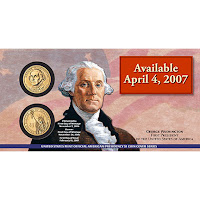 I was perusing the Mint’s online catalog to see what products are on the horizon. There, I found that the Mint will be issuing The American Presidency $1 Coin Cover Series. These covers will feature uncirculated Presidential Dollars from the Denver and Philadelphia mints from the first day of manufacturing. The coins will be attached to an envelope that will include a portrait of the President being honored and a paragraph describing his term of office. The envelope will have the prevailing stamp of the day and will be postmarked on the first day of issue in the president’s hometown. The Mint limits the production to 50,000 covers and cost $14.95—a bargain compared with similar offerings from other sources.
I was perusing the Mint’s online catalog to see what products are on the horizon. There, I found that the Mint will be issuing The American Presidency $1 Coin Cover Series. These covers will feature uncirculated Presidential Dollars from the Denver and Philadelphia mints from the first day of manufacturing. The coins will be attached to an envelope that will include a portrait of the President being honored and a paragraph describing his term of office. The envelope will have the prevailing stamp of the day and will be postmarked on the first day of issue in the president’s hometown. The Mint limits the production to 50,000 covers and cost $14.95—a bargain compared with similar offerings from other sources.
As opposed to the First Strikes or Early Releases coins designated by the third-party grading services, the coins included on the cover are from the first day of production for the coins. This makes them true first day of issue coins as guaranteed by the US Mint. This will be another interesting way to collect the new Presidential Dollar coins. I am looking forward to seeing these covers!
Image from the US Mint.
Mar 27, 2007 | coins, dollar
John Adams was the second President of the United States, the first to be a father of a future president, and the first president to occupy the White House. Adams was a career diplomat serving in France and Holland during the Revolutionary War. On his return to the new country, he became the first Vice President of the United States.
Adams will be featured on the second coin in the Presidential Dollar program. His coin is scheduled to be released in May. In the mean time, the US Mint is preparing for the release of this new coin. If you want to read about the creating of this coin, this article from the Patriot Ledger of Quincy, Massachusetts has a very good article. You may want to see the slide show that shows Mint Engraver Charles Vickers engraving the master plaster cast, rolls of coin metals, and other interesting pictures.
Mar 24, 2007 | coins, dollar, GSA, shows
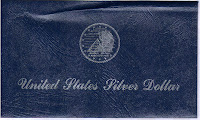 While walking around the ANA National Money Show on Saturday with my father, I met a dealer who had a blue envelope that said “United States Silver Dollar” in a fancy script on the cover with a 1922 Peace Dollar in a shrink wrap next to the envelope. I was intrigued and asked the dealer about the coin. The dealer removed it from his case and told me that he bought as part of a lot with other items. The dealer did not know much about the coin except that it was sold as part of a “GSA Hoard Sale” that was offered after the sale of the well known Carson City Dollars.
While walking around the ANA National Money Show on Saturday with my father, I met a dealer who had a blue envelope that said “United States Silver Dollar” in a fancy script on the cover with a 1922 Peace Dollar in a shrink wrap next to the envelope. I was intrigued and asked the dealer about the coin. The dealer removed it from his case and told me that he bought as part of a lot with other items. The dealer did not know much about the coin except that it was sold as part of a “GSA Hoard Sale” that was offered after the sale of the well known Carson City Dollars.
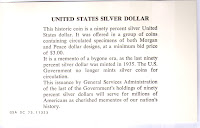
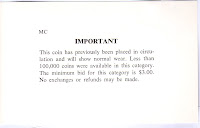 I like Peace Dollars. Aside from being a classic beauty, the are the first non-modern set I put together—which includes the 1928 Peace Dollar my fiancée (now my wife) bought for me as a gift! Within the envelop was the dollar shrink wrapped with a special GSA token and two information cards. One card was about the coin and the other about the sale. The more I looked, the more interested I became.
I like Peace Dollars. Aside from being a classic beauty, the are the first non-modern set I put together—which includes the 1928 Peace Dollar my fiancée (now my wife) bought for me as a gift! Within the envelop was the dollar shrink wrapped with a special GSA token and two information cards. One card was about the coin and the other about the sale. The more I looked, the more interested I became.
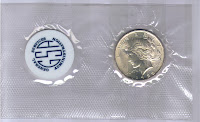 With loupe in hand, I looked closely at the coin. Even though the cards say that the coin is circulated, the dealer and I agreed that if it was circulated, that it was very lightly handled. Some wearing on Liberty’s cheek and neck along with the nice luster had both of us agreeing that the coin should grade MS62/63. The dealer was asking for a modest price over the price he paid, so I made the purchase.
With loupe in hand, I looked closely at the coin. Even though the cards say that the coin is circulated, the dealer and I agreed that if it was circulated, that it was very lightly handled. Some wearing on Liberty’s cheek and neck along with the nice luster had both of us agreeing that the coin should grade MS62/63. The dealer was asking for a modest price over the price he paid, so I made the purchase.
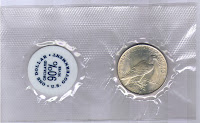 When I came home, I searched for more information and found this site that explained how the GSA sold what has been called the “GSA Hoard” that included the famed Carson City Dollars and over 100,000 additional circulated and uncirculated silver dollars. This report noted that there were “84,165 circulated and 27,980 uncirculated coins minted between 1859 and 1935.” The 84,165 circulated silver dollars were various types including Seated Liberty, Morgan and Peace Silver Dollars with mint marks from other US Mint branches.
When I came home, I searched for more information and found this site that explained how the GSA sold what has been called the “GSA Hoard” that included the famed Carson City Dollars and over 100,000 additional circulated and uncirculated silver dollars. This report noted that there were “84,165 circulated and 27,980 uncirculated coins minted between 1859 and 1935.” The 84,165 circulated silver dollars were various types including Seated Liberty, Morgan and Peace Silver Dollars with mint marks from other US Mint branches.
The article reports that the GSA never published the number that they sold of the blue softpack dollar. It is estimated that there were 100,000 of these coins sold.
The ANA National Money Show in Charlotte was a lot of fun. Now it is time to go to Baltimore for the Whitman Baltimore Coin and Currency Convention.
Mar 22, 2007 | counterfeit, dollar, errors, grading
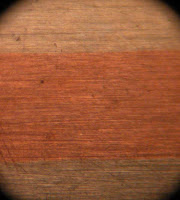 Numismatic Guarantee Corporation (NCG), published an article on their website warning about Washington Dollars with edges altered to resemble no-edge lettering errors. NGC said that “[less] than a month after their official release, Presidential $1 Coins with altered edges are being submitted to NGC for certification.” In the article, NGC provides detailed dimensions of the coins along with images of genuine and altered edges.
Numismatic Guarantee Corporation (NCG), published an article on their website warning about Washington Dollars with edges altered to resemble no-edge lettering errors. NGC said that “[less] than a month after their official release, Presidential $1 Coins with altered edges are being submitted to NGC for certification.” In the article, NGC provides detailed dimensions of the coins along with images of genuine and altered edges.
Collectors are urged to use the information to make informed decisions as to their purchase of these coins. Although it is popular to buy coins from online auction sites, collectors may want to ensure that the coins are certified from a reputable third party grading service. You may want to inquire as to the seller’s return policy should the coin be altered. Remember, a seven day return policy will not be enough time for a coin to be certified by most grading services. Here are some resources to learn more:
Image of altered Washington Dollar edge from NGC.
Mar 22, 2007 | coins, dollar, errors, US Mint
The US Mint announced the availability of Sacagawea Dollars this week. Under the provisions of the Presidential $1 Coin Act (GPO: [text]/[pdf]), the Mint has to produce one Sacagawea Dollar for every three Presidential Dollars struck. Since the Mint is scheduled to produce 300 million George Washington Dollars, they are required to strike 100 million Sacagawea Dollars to be in compliance with the law. According to the Mint, the 2007 Sacagawea Dollars will benefit from the improved processes developed for the Presidential Dollar Program including shinier surfaces and a treatment to prevent the unusual toning of the past.
Although the Glenna Goodacre design is one of the Mint’s best in recent memories, the coin has not gained popularity with the public. As long as the Bureau of Engraving and Printing continues to print one-dollar Federal Reserve Notes, one-dollar coinage will not be popular. The only significant circulation of these coins was in the year 2000, its first year of issue. That year, the Mint struck 1.2 billion coins which are reportedly still being warehoused by the Mint and the various Federal Reserve banks.
The proliferation of edge lettering errors has prompted a lot of discussion in the numismatic industry. Professional Coin Grading Service (PCGS) has joined the fray and announced rewards for finding specific types of errors caused by the edge lettering. Recently, PCGS awarded $2,500 to a Colorado collector who found a Presidential Dollar blank planchet with edge lettering.
Since the Sacagawea Dollar is struck on the same planchets, presses, and post finishing process as the Presidential Dollar without the edge lettering, there is speculation that some may appear with edge lettering. While some insist this type of error is highly unlikely because the edge lettering is a separate process, PCGS is offering a $10,000 reward for being able to certify a genuine Sacagawea Dollar with edge lettering of a Presidential Dollar.
If you find a Sacagawea Dollar with edge lettering, contact me through this blog. I would love to be first to report the find and post pictures.
Mar 14, 2007 | coins, dollar, errors
There have been reports of various minting errors for the new Washington Dollar coins, but a Denver couple found a number of blank planchets with edge lettering. Somehow, the coins missed the striking process but were processed passed inspectors to have the lettering pressed into the edge. Coins are from the Denver Mint Facility. There were no reports as to how many of this error may be in circulation.
Mar 14, 2007 | coins, dollar, grading, varieties
ANACS, the oldest certification service, has now published their population report. The report is accessible via the web and requires a free user account. Their population report not only includes the standard varieties, but also a listing of all of the errors of a particular type. For example, a search of 1976-P Type 2 Eisenhower Dollars shows that ANACS has graded Broadstruck, Clip, Double Clip, Double Struck, Die Adjustment Strike, Indent, Off-Center, Partial Collar, Split Planchet, Struck Thru, and Struck Thru Grease errors. I like that!
ANACS is also offering grading of Washington Dollars for $8 through March 31, 2007. There is a 10 coin minimum for their 10 day grading service. I may buy a roll from the bank and see what I can send to ANACS for grading because this is a good deal!
Mar 9, 2007 | coins, dollar, errors
Susan Headley, the Coins Guide on About.com, wrote a great frequently asked questions (FAQ) article that is worth reading. It sets the records straight as to what is known about the smooth or plain edge error on the George Washington Dollars. Read about it here.
Mar 9, 2007 | coins, dollar, errors, US Mint
A March 7, 2007 press release issued by the US Mint recognized “that an unspecified quantity of [George Washington Dollar] coins inadvertently left the United States Mint at Philadelphia without edge-lettering on them.” Calling it a quality control issue, the Mint said that they are “looking into the matter to determine a possible cause in the manufacturing process.”
Unfortunately, there are media abusers whose knee-jerk reaction was to call this a way to “remove God from our coins.” This could be the furthest from the truth and readers are advised to consider the source before trusting any information these smear merchants may pronounce.
Mar 8, 2007 | coins, dollar, errors, scams, varieties
If you search the online auction sites, you will find less than honest sellers trying to sell variations in the positioning of edge lettering of the new George Washington Dollars errors or varieties. Letters that are pointed up, or the top of the letters towards the obverse, are considered “normal” by these sellers. Letters that are pointed downward, or the top of the letters closer to the reverse of the coin, have been called errors or varieties. They are neither.
An accepted definition of a variety “is any variation in the normal design of a given coin, usually caused by errors in the preparation or maintenance of the coin dies.” They are also errors caused in the striking process. But these definitions do not account for the differences in the orientation. The problem is that after the planchets are struck into coins by the high speed coining machines, they are mechanically collected and fed into a machine that will press the lettering into the edge of the coins.
The machine that adds the edge lettering uses a three part collar to impress the incuse lettering does this without regard to position. not only could the edge lettering face any direction, but the lettering can appear at any position along the edge. The US Mint confirms this by saying that because of “the minting process used on the circulating coins, the edge-incused inscription positions will vary with each coin.”
Since the Mint is saying that the process can vary, these variations are normal for the design. Since these are normal variations, they are not numismatic varieties or errors. Thus, the coins with variations of orientation edge lettering are not worth the premiums being sought online. They are worth their face value of $1.
There have been errors found with the edge lettering. The most infamous has been called the “Godless Dollars” for coins missing their edge lettering and the motto “In God We Trust.” Most of these coins were minted in Philadelphia and discovered in Florida. Others have found doubling of edge letters and what looks like breaks in the three-part collars where letters have moved out of place. These are legitimate errors and worth a premium above face value. Orientation variations of the edge lettering are not errors.
If you want to consider these varieties, please save your money and visit your local bank. You can purchase these coins for face value without shipping and handling fees. If you purchase a 25-coin roll, you can spend the coins you do not want since they are legal tender.
 I was perusing the Mint’s online catalog to see what products are on the horizon. There, I found that the Mint will be issuing The American Presidency $1 Coin Cover Series. These covers will feature uncirculated Presidential Dollars from the Denver and Philadelphia mints from the first day of manufacturing. The coins will be attached to an envelope that will include a portrait of the President being honored and a paragraph describing his term of office. The envelope will have the prevailing stamp of the day and will be postmarked on the first day of issue in the president’s hometown. The Mint limits the production to 50,000 covers and cost $14.95—a bargain compared with similar offerings from other sources.
I was perusing the Mint’s online catalog to see what products are on the horizon. There, I found that the Mint will be issuing The American Presidency $1 Coin Cover Series. These covers will feature uncirculated Presidential Dollars from the Denver and Philadelphia mints from the first day of manufacturing. The coins will be attached to an envelope that will include a portrait of the President being honored and a paragraph describing his term of office. The envelope will have the prevailing stamp of the day and will be postmarked on the first day of issue in the president’s hometown. The Mint limits the production to 50,000 covers and cost $14.95—a bargain compared with similar offerings from other sources.





